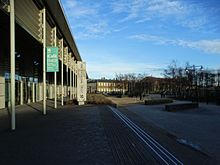National Trust, formally National Trust for Places of Historic Interest or Natural Beauty, is a charity and membership organisation for heritage conservation in England, Wales and Northern Ireland. In Scotland, there is a separate and independent National Trust for Scotland.
The Trust was founded in 1895 by Octavia Hill, Sir Robert Hunter and Hardwicke Rawnsley to "promote the permanent preservation for the benefit of the Nation of lands and tenements (including buildings) of beauty or historic interest". It was given statutory powers, starting with the National Trust Act 1907. Historically, the Trust acquired land by gift and sometimes by public subscription and appeal, but after World War II the loss of country houses resulted in many such properties being acquired either by gift from the former owners or through the National Land Fund. Country houses and estates still make up a significant part of its holdings, but it is also known for its protection of wild landscapes such as in the Lake District and Peak District.
In addition to the great estates of titled families, it has acquired smaller houses, including some whose significance is not architectural but through their association with famous people, for example, the childhood homes of singer/composers John Lennon and Paul McCartney of the Beatles.
One of the largest landowners in the United Kingdom, the Trust owns almost 250,000 hectares (620,000 acres; 2,500 km2; 970 sq mi) of land and 780 miles of coast. Its properties include more than 500 historic houses, castles, archaeological and industrial monuments, gardens, parks and nature reserves. Most properties are open to the public for a charge (members have free entry), while open spaces are free to all. The Trust has an annual income of over £680 million, largely from membership subscriptions, donations and legacies, direct property income, profits from its shops and restaurants, and investments. It also receives grants from a variety of organisations including other charities, government departments, local authorities and the National Lottery Heritage Fund.
https://en.wikipedia.org/wiki/National_Trust
 | |
| Abbreviation | National Trust |
|---|---|
| Formation | 1895 |
| Legal status | Trust |
| Purpose | To look after Places of Historic Interest or Natural Beauty permanently for the benefit of the nation across England, Wales and Northern Ireland |
| Headquarters | Heelis, Swindon, Wiltshire, England |
| Location |
|
Region served | England, Wales and Northern Ireland |
Membership | 5.95 million (2019/20)[1] |
Key people |
|
Main organ | Board of trustees |
Revenue | £681 million (2019/20)[1] |
Staff | 14,000[1] |
Volunteers | 53,000[1] |
| Website | www |
Governance[edit]
The trust is an independent charity (no. 205846). It was founded as a not-for-profit company in 1895 but was later re-incorporated by a private Act of Parliament, the National Trust Act 1907. Subsequent acts of Parliament between 1919 and 1971 amended and extended the Trust's powers and remit. The governance of the Trust was amended by the Charities (National Trust) Order 2005.[4]
The Trust is governed by a board of trustees (of between nine and fifteen members), appointed and overseen by a council consisting of eighteen people elected by the members of the Trust and eighteen appointed by other organisations whose work is related to that of the Trust, such as the Soil Association, the Royal Horticultural Society and the Council for British Archaeology. The members periodically vote on the organisations which may appoint half of the council. Members may also propose and vote on motions at the annual general meeting.[22][23]
At an operational level, the Trust is organised into regions which are aligned with the official local government regions of the UK. Its headquarters are in Swindon.[24]
In 2019/20 the Trust was employing 14,000 staff, including about 4,000 seasonal workers.[1] Since 2009, customer services have been outsourced to Capita.[25] The director-general of the Trust, Hilary McGrady, is paid an annual salary of £195,700, with a further eight executives being paid over £100,000 a year.[1] The Trust is not a real living wage employer.[26] In July 2020 the Trust announced that 1,200 jobs were at risk due to the coronavirus pandemic.[27]
治理
該信託是一個獨立的慈善機構(編號 205846)。 它成立於 1895 年,是一家非營利性公司,但後來通過議會的一項私人法案,即 1907 年《國家信託法》重新組建。1919 年至 1971 年的後續議會法案修改並擴大了信託的權力和職權範圍。 信託的治理由 2005 年慈善機構(國家信託)令修訂。 [4]
該信託由受託人委員會(9 至 15 名成員組成)管理,該委員會由理事會任命和監督,理事會由信託成員選出的 18 人和與信託工作相關的其他組織任命的 18 人組成 ,如土壤協會、皇家園藝學會和英國考古委員會。 成員定期投票選出可任命半數理事會成員的組織。 成員還可以在年度股東大會上提出議案並對其進行表決。 [22][23]
在運營層面,信託被組織成與英國官方地方政府區域一致的區域。 它的總部位於史雲頓。 [24]
在 2019/20 年度,信託基金僱用了 14,000 名員工,其中包括約 4,000 名季節性工人。[1] 自 2009 年以來,客戶服務已外包給 Capita。 [25] 信託基金總幹事希拉里·麥克格雷迪 (Hilary McGrady) 的年薪為 195,700 英鎊,另外八名高管的年薪超過 100,000 英鎊。 [1] 信託基金不是真正的生活工資雇主。 [26] 2020 年 7 月,信託宣布 1,200 個工作崗位因冠狀病毒大流行而面臨風險。 [27]
Protection of National Trust property[edit]
The National Trust Acts grant the Trust the unique statutory power to declare land inalienable. This prevents the land from being sold or mortgaged against the Trust's wishes without special parliamentary procedure. The inalienability of trust land was over-ridden by Parliament in the case of proposals to construct a section of the Plympton bypass through the park at Saltram, on the grounds that the road proposal had been known about before the park at Saltram was declared inalienable.[3]: 215-216
In 2017 the Trust, in spite of criticism by members, supported the government's scheme to build a road tunnel under the Stonehenge World Heritage Site as part of the plans to upgrade the A303 road. The scheme would involve the compulsory purchase of land held inalienably by the Trust.[38]
保護國家信託財產
國家信託法授予信託基金宣布土地不可轉讓的獨特法定權力。 這可以防止在未經特殊議會程序的情況下違背信託基金的意願出售或抵押土地。 在提議修建穿過 Saltram 公園的 Plympton 旁路路段的提案時,議會否決了信託土地的不可轉讓性,理由是在 Saltram 公園被宣佈為不可轉讓之前就已經知道了道路提案。 [3]:‰215-216
2017 年,儘管受到成員的批評,該信託仍支持政府在巨石陣世界遺產地下方修建公路隧道的計劃,作為 A303 公路升級計劃的一部分。 該計劃將涉及強制購買信託不可轉讓地持有的土地。 [38]

沒有留言:
張貼留言